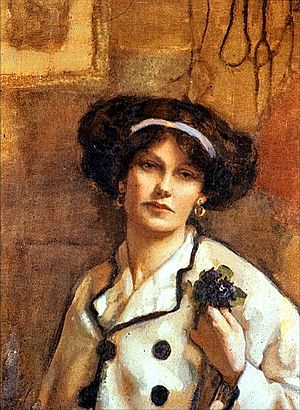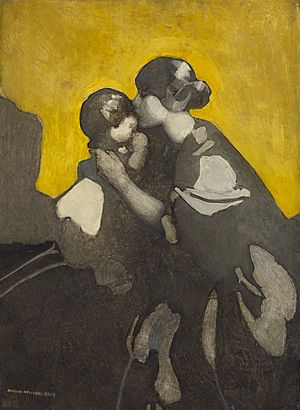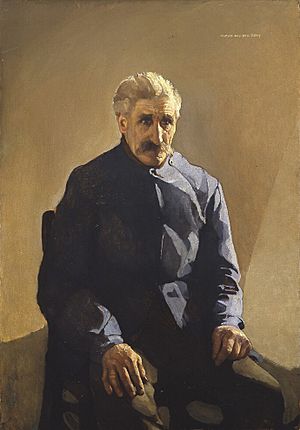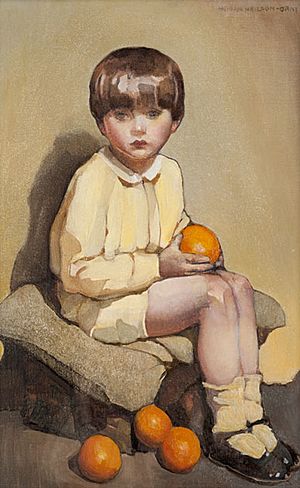Norah Neilson Gray facts for kids
Quick facts for kids
Norah Neilson Gray
|
|
|---|---|

Self portrait (1918)
|
|
| Born | 16 June 1882 Helensburgh, Scotland
|
| Died | 27 May 1931 (aged 48) Glasgow, Scotland
|
| Nationality | Scottish |
| Alma mater | Glasgow School of Art |
| Occupation | artist, portrait painter |
| Known for | portraits |
Norah Neilson Gray (born June 16, 1882 – died May 27, 1931) was a talented Scottish artist. She was part of a famous art movement called the Glasgow School. Norah showed her paintings at important art shows like the Royal Academy in London and the Paris Salon. She was also a member of a special group known as The Glasgow Girls. Their beautiful paintings were shown in Kirkcudbright in 2010.
| Top - 0-9 A B C D E F G H I J K L M N O P Q R S T U V W X Y Z |
Norah's Early Life and Art Training
Norah Neilson Gray was born in Helensburgh, Scotland, in 1882. Her father, George Gray, owned a shipping business in Glasgow. Her mother, Norah Neilson, came from a family of auctioneers.
Learning to Paint
Norah first learned art from two local teachers, Misses Park and Ross. They had a studio near Helensburgh. In 1901, Norah and her family moved to Glasgow. This allowed her to attend the famous Glasgow School of Art. She studied there until 1906. Her teachers included the Belgian artist Jean Delville and Fra Newbery.
First Exhibitions
Even while she was still a student, Norah's talent was clear. In 1905, her painting of her sister, Gerty, was chosen to be shown at the Royal Academy in London. This was a big achievement! After finishing art school in 1906, Norah taught fashion drawing there.
Norah also taught art at St Columba's School, Kilmacolm, which was a girls' school. People sometimes called her "Purple Patch." This was because she always said you could see colors in shadows if you looked closely enough. By 1910, Norah was showing her portraits regularly. Her art appeared at the Royal Academy, the Royal Glasgow Institute of the Fine Arts, and the Paris Salon. She even had her own art studio in Glasgow. Her first solo art show was at Warneuke's Gallery in Glasgow.
New Painting Styles
In 1914, Norah became a member of the Royal Scottish Society of Painters in Watercolour. She also created illustrations for a book by the poet William Wordsworth. Norah tried a new painting style called Pointillism for her 1914 painting, The Missing Trawler. This painting is now kept at the Kelvingrove Art Gallery and Museum.
Norah's Art During World War One
During World War I, Norah Neilson Gray created some of her most important artworks. Her painting The Country's Charge (1915) shows a woman and child wrapped in a shawl. This painting was shown at the Royal Academy. It was sold to help the Red Cross and then given to the Royal Free Hospital.
Paintings of Refugees and Hospitals
Another famous painting from this time is The Belgian in Exile (1915). It shows a refugee from Liège, Belgium, who had escaped to Scotland after his country was invaded. This painting was shown in Glasgow and London. In 1921, it won a bronze medal at the Paris Salon.
During the war, Norah also volunteered as a nurse. She worked with the Scottish Women's Hospitals in France. Even while nursing, she found time to paint and sketch. One of her paintings, Hôpital Auxilaire 1918, shows the inside of Royaumont Abbaye. This old abbey near Paris was turned into a hospital run by women. It was staffed by the Scottish Women's Hospitals. Norah's second painting of the hospital, The Scottish Women's Hospital In The Cloister of the Abbaye at Royaumont. Dr Frances Ivens inspecting a French patient, was accepted by the Imperial War Museum in 1920.
Later Life and Legacy
After World War One, Norah went back to painting portraits. She often painted young women and children. In 1923, she won a silver medal at the Paris Salon for her painting Le Jeune Fille. Norah was also the first woman to join an important committee for the Royal Glasgow Institute of the Fine Arts. This committee decided which artworks would be displayed.
Norah Neilson Gray sadly died of cancer in Glasgow on May 27, 1931. She was 48 years old.
Norah's Art Today
Norah's paintings are now in several national art collections. In 2010, an exhibition called The Glasgow Girls featured her paintings in Kirkcudbright Town Hall. Her painting Little Brother is at the Kelvingrove Art Gallery and Museum. In 1978, Norah's sister, Tina, gave the painting Hôpital Auxilaire 1918 to Helensburgh. It now hangs in the town's library for everyone to see.
Images for kids








